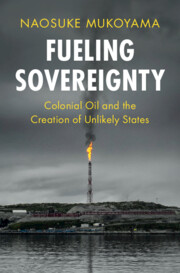123 results
2 - The Bolsheviks and Oil
-
- Book:
- Fuel and Power
- Print publication:
- 27 June 2024, pp 31-70
-
- Chapter
- Export citation
4 - Establishing Ties with Apartheid South Africa
- from Part I - Establishing Relations (c. 1957–1970)
-
- Book:
- Pahlavi Iran's Relations with Africa
- Print publication:
- 27 June 2024, pp 94-116
-
- Chapter
- Export citation
Chapter 3 - Oil Empire and Japan’s Southern Advance
-
- Book:
- Yukikaze's War
- Print publication:
- 06 June 2024, pp 43-61
-
- Chapter
- Export citation
5 - From the Magi to Industrial Function
- from Stage 2 - Research in the Early Twentieth Century
-
- Book:
- Applied Science
- Published online:
- 15 March 2024
- Print publication:
- 28 March 2024, pp 118-165
-
- Chapter
- Export citation
3 - Colonial Oil and Decolonization in Borneo
-
- Book:
- Fueling Sovereignty
- Published online:
- 14 March 2024
- Print publication:
- 21 March 2024, pp 56-96
-
- Chapter
- Export citation
4 - Colonial Oil and Decolonization in the Lower Gulf
-
- Book:
- Fueling Sovereignty
- Published online:
- 14 March 2024
- Print publication:
- 21 March 2024, pp 97-137
-
- Chapter
- Export citation
1 - Introduction
-
- Book:
- Fueling Sovereignty
- Published online:
- 14 March 2024
- Print publication:
- 21 March 2024, pp 1-26
-
- Chapter
- Export citation
2 - Theory of Separate Independence
-
- Book:
- Fueling Sovereignty
- Published online:
- 14 March 2024
- Print publication:
- 21 March 2024, pp 27-55
-
- Chapter
- Export citation
5 - Separate Independence in Other Settings
-
- Book:
- Fueling Sovereignty
- Published online:
- 14 March 2024
- Print publication:
- 21 March 2024, pp 138-157
-
- Chapter
- Export citation

Fueling Sovereignty
- Colonial Oil and the Creation of Unlikely States
-
- Published online:
- 14 March 2024
- Print publication:
- 21 March 2024
5 - The Energy Problem
-
- Book:
- The Russia Sanctions
- Published online:
- 14 December 2023
- Print publication:
- 21 December 2023, pp 53-65
-
- Chapter
- Export citation
7 - Legacy Energy Transitions
- from Part II - Net-Zero-Carbon Transitions
-
- Book:
- Dynamic Sustainability
- Published online:
- 07 December 2023
- Print publication:
- 21 December 2023, pp 82-97
-
- Chapter
- Export citation
A QTL allele from wild soybean enhances protein content without reducing the oil content
-
- Journal:
- Plant Genetic Resources / Volume 21 / Issue 5 / October 2023
- Published online by Cambridge University Press:
- 29 November 2023, pp. 409-417
-
- Article
- Export citation
Vertical Integration Among Oil-producing Countries
-
- Journal:
- Enterprise & Society , First View
- Published online by Cambridge University Press:
- 23 November 2023, pp. 1-23
-
- Article
- Export citation
With Statoil as a Prism: Revisiting Key Features and Concerns in Western Oil Companies’ Evolving Human Rights Awareness, From the Mid-1990s to the 2000s
-
- Journal:
- Enterprise & Society , First View
- Published online by Cambridge University Press:
- 06 November 2023, pp. 1-27
-
- Article
-
- You have access
- Open access
- HTML
- Export citation
Chapter 2 - Chicago Schools
- from Part I - Critical Approaches
-
-
- Book:
- The Cambridge Companion to the City in World Literature
- Published online:
- 13 July 2023
- Print publication:
- 27 July 2023, pp 17-31
-
- Chapter
- Export citation
6 - Fueling Authoritarian Resilience
- from Part III - The Impact of Contemporary Rents on Dictatorship and Violence
-
- Book:
- Conquests and Rents
- Published online:
- 01 June 2023
- Print publication:
- 15 June 2023, pp 179-205
-
- Chapter
- Export citation
7 - Aiding Political Violence
- from Part III - The Impact of Contemporary Rents on Dictatorship and Violence
-
- Book:
- Conquests and Rents
- Published online:
- 01 June 2023
- Print publication:
- 15 June 2023, pp 206-235
-
- Chapter
- Export citation
2 - Analytical Framework
- from Part I - A Political Economy Approach
-
- Book:
- Conquests and Rents
- Published online:
- 01 June 2023
- Print publication:
- 15 June 2023, pp 24-60
-
- Chapter
- Export citation
10 - Building Japan’s Oil Empire
- from Part II - Environment, Economy, and Technology
-
-
- Book:
- The New Cambridge History of Japan
- Published online:
- 19 May 2023
- Print publication:
- 08 June 2023, pp 373-400
-
- Chapter
- Export citation



